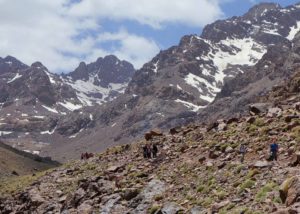The specialized technique of hooking is one of the trickiest aid climbing moves that you will make on a big wall. Hooking, especially if you are a beginning aid climber, is usually scary. Think about it: you’re standing on a tiny piece of steel hooked on an edge on a steep blank face. Your aiders are clipped to a sling attached to the hook. Your feet dangle in the aiders.
Standing there, you feel precarious. You feel that any movement will cause the hook to pop off the edge, sending you falling and flying. It is a special thrill to successfully make a series of hook moves on your pitch.
Carry 3 Types of Hooks
Most aid pitches on big walls usually require only three types of hooks. These are the best hooks to carry on your aid rack:
Cliffhanger Hook
The Cliffhanger Hook, made by Black Diamond, is the classic hook style that is used on most aid routes. The Cliffhanger has a flat chiseled point and a flat tip for stability on flakes and edges. The bottom of the hook is bipodal to reduce rotation and keep it stable when weighted.
Some aid routes require Cliffhanger hooks with the tip filed to a sharp triangular point for use in a shallow, drilled 1/4-inch-deep hole on blank faces. A pointed hook is sometimes called a Bat hook, a name given by the great Yosemite climber Warren Harding, who often drilled several shallow holes in a row to avoid drilling deeper holes and placing bolts. These pointed hooks are seldom used on routes except in drilled holes since more weight is transferred onto the point, which can break edges.
Grappling Hook
The Grappling Hook, another Black Diamond hook, is similar in shape and design to the Cliffhanger but is more stable and works on a greater variety of edges and flakes. Its wide, flat, chiseled point grabs edges, especially big ones, and its wide base with flared feet makes it stable when weighted.
The Grappling Hook is one of the best hooks for your aid rack. Buy and use two or three on your climbs and you’ll feel solid on almost every hook placement. Like the Cliffhanger, you can also file and sharpen the point for use in Bat hook holes.
Talon Hook
The Talon Hook, also made by Black Diamond, is the third hook to carry on your rack of aid gear. The Talon, like the foot of a raptor, is a three-pronged hook, with each arm of equal length. The tip of each prong, however, makes the Talon a useful piece of aid climbing equipment. Each tip offers a different shape for different edges—pointed, medium wide, and wide. The width of the bottom prongs when the hook is used keeps it stable. The hook covers edges from 4.8mm (3/16-inch) to 13mm (1/2-inch). The pointed hook works well in shallow Bat holes.
Other Types of Hooks
Some aid climbing routes might require larger hooks than these three, including a ring-angle hook made from an old soft-iron Army angle piton like the Fish Hook Angle Claw or a Fish Hook, from Fish Products. These large hooks are great for hooking big flakes and wide ledges.
Aid climbers also use Cam Hooks, a large, strong hook that is wedged or cammed in thin cracks, seams, and piton scars. Cam Hooks are your best friend on big walls, but they are not hooks that you use on flakes and edges so they are not described here.
Another type of hook is a Black Diamond Pecker or a Moses Tomahawk. These are used as pitons but placed by hand, without hammering, in thin cracks, seams, and piton scars. Again, these are essential modern climbing tools for Yosemite big wall routes, but they are not hooks, even though they use a hooking placement to seat themselves.
Differences between Hooks, Cam Hooks and Pitons in Aid Climbing
- Hooks:
- Usage: Hooks are typically used in aid climbing for temporarily attaching to small features like edges, flakes, and drilled holes (Bat holes). They are passive devices that rely on gravity and the climber’s weight to stay in place.
- Advantages: They are lightweight and cause minimal damage to the rock. Hooks are invaluable for navigating features that are too small or delicate for other gear.
- Limitations: Their hold is less secure compared to other gear types. Hooks are not designed for sustained weight or dynamic loads and are usually used for short, delicate moves where other gear cannot be placed.
- Cam Hooks:
- Usage: Cam hooks are a type of active protection. They are placed into thin cracks and “cam” against the rock when weighted, securing the climber without the need for hammering.
- Advantages: More secure than standard hooks, cam hooks can be used in thin cracks where traditional cams won’t fit. They are faster to place and remove than pitons and cause less rock damage.
- Limitations: They require more skill to place effectively and are limited to specific crack sizes. They are not suitable for use on flat surfaces or small edges where regular hooks excel.
- Pitons:
- Usage: Pitons are metal spikes that are hammered into cracks in the rock. They are used in situations where other forms of protection are not viable.
- Advantages: They offer a very secure form of protection, especially in wider cracks and irregular features where cams and hooks cannot be placed.
- Limitations: Pitons cause significant damage to the rock, altering the climbing route permanently. They are also heavier and require more time and effort to place and remove, making them less desirable for rapid ascents.
Choosing the Right Gear:
- The choice between hooks, cam hooks, and pitons depends on the specific challenges of the route and the features available for protection.
- Hooks are ideal for short moves on delicate features, cam hooks work well in thin cracks where speed and minimal rock damage are priorities, and pitons are reserved for more challenging placements where security is paramount.
In summary, while hooks, cam hooks, and pitons all serve the purpose of aiding climbers on difficult sections of a climb, their applications, advantages, and limitations vary greatly. Understanding these differences is crucial for climbers to make informed decisions about which gear to use in different scenarios on a climb.








